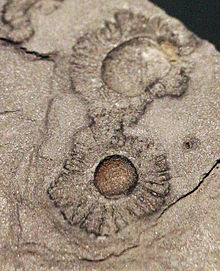
Back حيويات فرانسفيلية Arabic Gabonionta German Biota francevillense Spanish زیواگان فرانسویلین Persian Groupe fossile de Franceville French Biota Francevillian ID Gabonionta Polish Biota Francevilliana Portuguese Biota Francevilliană Romanian Франсвильская биота Russian

The Francevillian biota (Also referred to as Gabon macrofossils, Gabonionta or Francevillian group fossils) are a collection of 2.1-billion-year-old Palaeoproterozoic macroscopic structures, controversially suggested to be fossils, known from the Francevillian B Formation in Gabon, a black shale province notable for its lack of any noticeable metamorphism.[1] The structures have been postulated by some authors to be evidence of the earliest form of multicellular life, and of eukaryotes.[1][2] They were discovered by an international team led by Moroccan-French geologist Abderrazak El Albani, of the University of Poitiers, France. While they have yet to be assigned to a formal taxonomic position, they have been informally and collectively referred to as the "Gabonionta", including by the Natural History Museum Vienna in 2014.[3] The status of the structures as fossils has been questioned, and they remain a subject of debate.[4][5]
| Part of a series on |
| The Francevillian basin |
|---|
 |
- ^ a b El Albani, Abderrazak; Bengtson, Stefan; Canfield, Donald E.; Riboulleau, Armelle; Rollion Bard, Claire; Macchiarelli, Roberto; et al. (2014). "The 2.1 Ga Old Francevillian Biota: Biogenicity, Taphonomy and Biodiversity". PLOS ONE. 9 (6): e99438. Bibcode:2014PLoSO...999438E. doi:10.1371/journal.pone.0099438. PMC 4070892. PMID 24963687.
- ^ El Albani, Abderrazak (2023). "A search for life in Palaeoproterozoic marine sediments using Zn isotopes and geochemistry". Earth and Planetary Science Letters. 623: 118169. Bibcode:2023E&PSL.61218169E. doi:10.1016/j.epsl.2023.118169. S2CID 258360867.
- ^ Experiment Life – the Gabonionta. (Press Release). 4 March 2014. Naturhistorisches Museum Wien
- ^ Javaux, Emmanuelle J.; Lepot, Kevin (January 2018). "The Paleoproterozoic fossil record: Implications for the evolution of the biosphere during Earth's middle-age". Earth-Science Reviews. 176: 68–86. Bibcode:2018ESRv..176...68J. doi:10.1016/j.earscirev.2017.10.001. hdl:20.500.12210/62416. S2CID 37069547.
The identity of the [Francevillian biota] macrostructures remains unknown and their biogenicity is questionable
- ^ Fakhraee, Mojtaba; Tarhan, Lidya G.; Reinhard, Christopher T.; Crowe, Sean A.; Lyons, Timothy W.; Planavsky, Noah J. (May 2023). "Earth's surface oxygenation and the rise of eukaryotic life: Relationships to the Lomagundi positive carbon isotope excursion revisited". Earth-Science Reviews. 240: 104398. Bibcode:2023ESRv..24004398F. doi:10.1016/j.earscirev.2023.104398. S2CID 257761993.